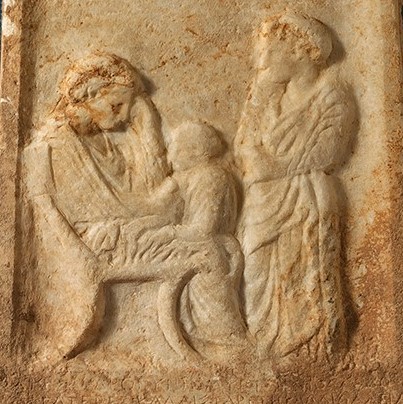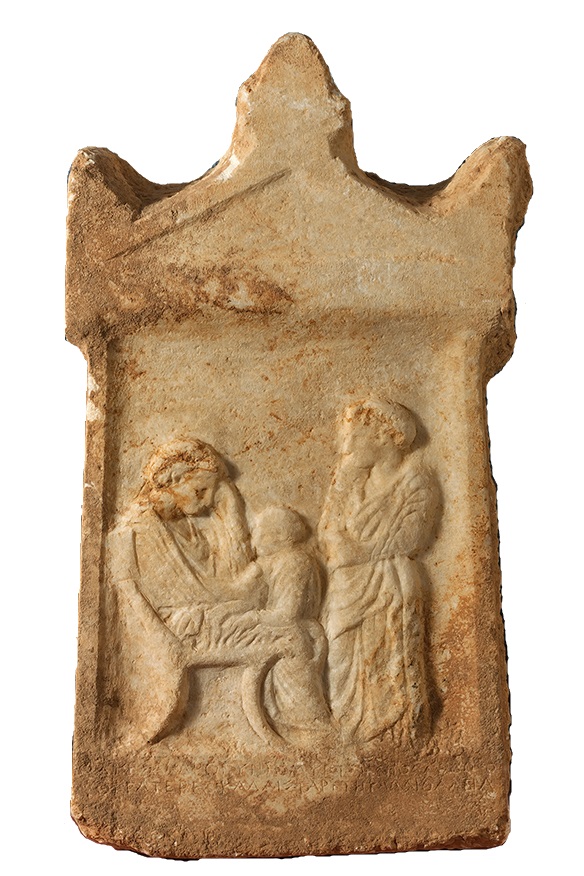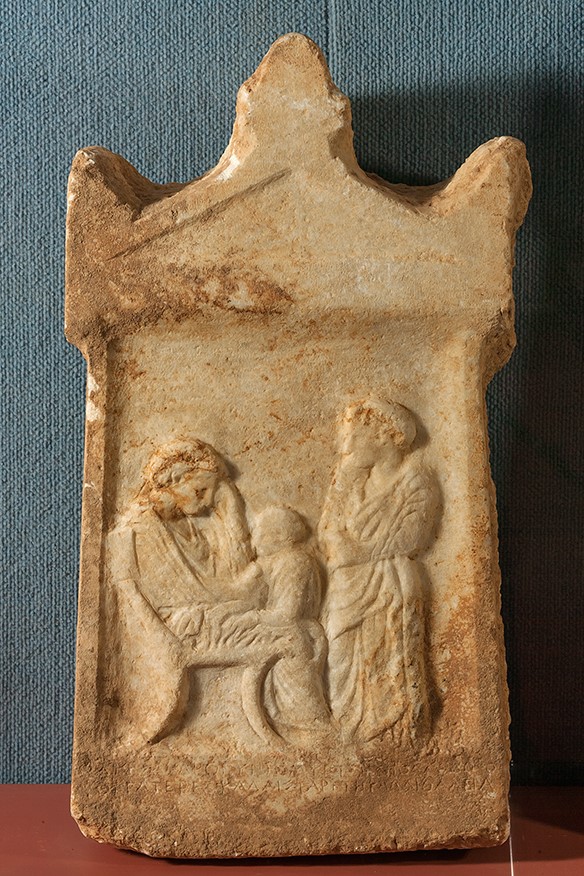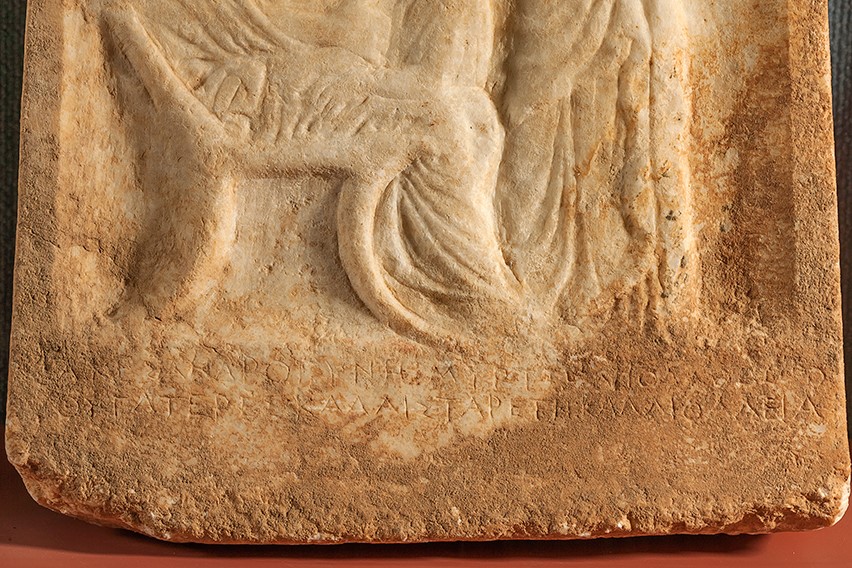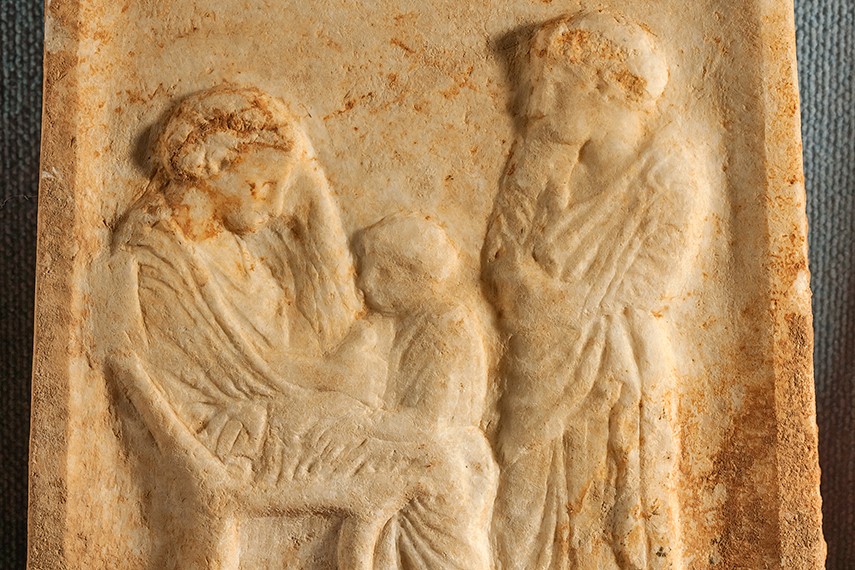Acquisition number: 1978.01
White crystalline marble, looking like poorer-quality Pentelic. There is incrustation on the surface around the bottom and at the upper left.
The scene has a seated woman at the left, dressed in chiton and himation and with her left hand by her head. She holds her right hand forward to a little girl standing at her knee. Facing her to the right stands another woman, also wearing chiton and himation.
The figures are carved in shallow relief with simple grooves for the folds of the drapery. There are some slight traces of red paint at the bottom of the scene. The entablature must also have been painted. The acroteria are roughly shaped and the front face left smooth. The pedimental area is left slightly rough. The top of the stele is left rough and the marks of the punch are clearly visible; the bottom is treated similarly. The sides are trimmed with the claw chisel to a depth of about 8cm from the face although the stele varies in thickness from ca 8cm on one side to ca 16cm on the other. There is relatively little below the figure-panel and part of that area is used for the inscription:
ΑΚΕΣΑΝΔΡΟΓΥΝΗ:ΜΥΡΤΩ:ΑΠΟΛΟΔΩΡΟ
θΥΓΑΤΕΡΕΣ:ΚΑΛΛΙΣΤΑΡΕΤΗ:ΚΑΛΛΙΘΑΛΕΙΑ
Ἀκεσάνδρο γύνη Μυρτώ Ἀπολλοδώρο
Θυγατέρες Καλλισταρέτη Καλλιθάλεια
“Myrto, wife of Akesandros, daughter of Apollodoros; (her) daughters Kallistarete, Kallithaleia.”
Title: Grave Stele - 1978.01
Acquisition number: 1978.01
Author or editor: J.R. Green
Culture or period: Greek Classical.
Date: Late 5th century BC.
Material: Stone - Marble
Object type: Funerary items - Grave stelae
Dimensions: 358mm (w) × 660mm (h)
Origin region or location: Greece
Origin city: Attika
Display case or on loan: 6
Keywords: Greek, Classical, Attic, Inscription, stele, Myrto, Kallistarete, Kallithaleia
Sotheby Parke Bernet (New York), Sale Cat., 11 July 1977, no. 328, pl. 49; J.R. Green with B. Rawson, Catalogue of Antiquities in the Australian National University, A.N.U. (Canberra, 1981), 88-89; Supplementum epigraphicum graecum XXXIII, 1983, 78-79 no. 233; C.W. Clairmont, Classical Attic Tombstones (Kilchberg 1993) 658-659 no. 2.724 (ill.); M.J. Osborne and S.J. Byrne, A Lexikon of Greek Personal Names ii. Attica (Oxford 1994) svv; A. Scholl, Die attischen Bildfeldstelen des 4. Jhs. v. Chr. (AthMitt Beiheft 17, Berlin 1996) 46 and cat. no. 381.
1978.01
Grave Stele
Purchased. Max. ht 66cm; max. width 35.8cm; ht recessed area 35.5cm.
White crystalline marble, looking like poorer-quality Pentelic. There is incrustation on the surface around the bottom and at the upper left.
The scene has a seated woman at the left, dressed in chiton and himation and with her left hand by her head. She holds her right hand forward to a little girl standing at her knee. Facing her to the right stands another woman, also wearing chiton and himation.
The figures are carved in shallow relief with simple grooves for the folds of the drapery. There are some slight traces of red paint at the bottom of the scene. The entablature must also have been painted. The acroteria are roughly shaped and the front face left smooth. The pedimental area is left slightly rough. The top of the stele is left rough and the marks of the punch are clearly visible; the bottom is treated similarly. The sides are trimmed with the claw chisel to a depth of about 8cm from the face although the stele varies in thickness from ca 8cm on one side to ca 16cm on the other. There is relatively little below the figure-panel and part of that area is used for the inscription:
ΑΚΕΣΑΝΔΡΟΓΥΝΗ:ΜΥΡΤΩ:ΑΠΟΛΟΔΩΡΟ
θΥΓΑΤΕΡΕΣ:ΚΑΛΛΙΣΤΑΡΕΤΗ:ΚΑΛΛΙΘΑΛΕΙΑ
Ἀκεσάνδρο γύνη Μυρτώ Ἀπολλοδώρο
Θυγατέρες Καλλισταρέτη Καλλιθάλεια
“Myrto, wife of Akesandros, daughter of Apollodoros; (her) daughters Kallistarete, Kallithaleia.”
The interpretation of the relief presents a number of intriguing problems. That the seated woman is to be thought of as Myrto, there can be no doubt. She is the first mentioned in the inscription (after her husband) and she is in the honoured position (see N. Himmelmann, Studien zum Ilissos-Relief [Munich 1956] 29 on the ‘heroisation’ of figures). Her left hand is by her head: it is probably to be interpreted not so much as the gesture of sorrow (after all her daughter[s] is/are with her) as a not-very-clear version of the standard wifely gesture of holding out the mantle at the side of the head. The small figure standing by her knees, to whom she extends her right hand, is doubtless a daughter.
More difficult is the identity of the woman on the right. Part of the problem rests in the position of the right arm. It is possible that her right hand is to her chin with her left supporting the right elbow. This is a common gesture to signify worry or distress: compare K. Friis Johansen, The Attic Grave Reliefs of the Classical Period: An Essay in Interpretation (Copenhagen 1951) 44-45 figs. 23-24 and see G. Neumann, Gesten und Gebärden in der griechischen Kunst (Berlin 1965) 125-152. Yet the carving is not distinct enough to be sure that the right arm is not bent across the waist (although that would leave a problem with the position of the left arm, since arms folded across the waist is not a common pose in these scenes). This woman’s age is depicted as much the same as that of Myrto, but, as usual in classical Greek art, age is indicated only in very broad, idealistic terms and in this case it would simply indicate that the figure is no longer a child. It is possible, therefore, that she is the other, older daughter; but it would be unusual to have two daughters represented, and it is in many ways easier to interpret the scene as a version of the more standard format of mistress and maid. In this case, the gravestone would, as usual, have been given more particular reference by the inscription.
Although the quality of the carving makes questions of chronology difficult, the letter forms of the inscription suggest the late fifth century. The iconography, on the other hand, might suggest a somewhat later date, in the first quarter of the fourth century. Scholl, nonetheless, dates it on stylistic grounds to the last decade of the fifth century, even if with some hesitation (see below).
The primary source for the study of Athenian grave reliefs is now Clairmont’s Classical Attic Tombstones (Kilchberg 1993). He discusses this piece in some detail, also pointing out that the sequence of names would be unique for an Attic memorial. It remains possible that the tombstone was made in provincial Attica, but Clairmont would prefer the idea that it was made under Attic influence in some other region, perhaps central Ionia. Scholl takes it as Attic. [I have not seen M. Salta, Attische Grabstelen mit Inschriften. Beiträge zur Topographie und Prosopographie der Nekropolen von Athen, Attika und Salamis von Peloponnesische Krieg bis zur Mitte des 4. Jhs. v. Chr. (Diss. Tübingen 1991).]
The technique with its simple carving and shallow relief is that of the so-called “Bildfeldstelen”: see H. Riemann, Kerameikos II. Die Skulpturen vom 5. Jahrhundert bis in römische Zeit (Berlin 1940) 19ff. with pll. 4-8, and e.g. H. Möbius, Die Ornamente der griechischen Grabstelen (Munich 2nd ed. 1968) pll. 8a, 10a, 16a, etc., and then the comprehensive study by Andreas Scholl Die attischen Bildfeldstelen des 4. Jhs. v. Chr. (AthMitt Beiheft 17, Berlin 1996) 46. One may compare, for example, the stele of the nurse Pyrrhaichme, published with useful discussion by S. Karouzou in Hellenika 15, 1957, 311-323, pll. 6-7 (a detail, AthensAnnals of Archaeology 9, 1977, 113). It is dated to the earlier part of the fourth century. Also relevant for both style and subject-matter is E. Pfuhl and H. Möbius, Die ostgriechischen Grabreliefs (Mainz 1977) pl. 18 no. 71.
For comparative letter-forms, see the illustrations of a series of dated inscriptions in J.E. Kirchner and G. Klaffenbach, Imagines Inscriptionum Atticarum. Ein Bilderatlas epigraphischer Denkmäler Attikas (2nd ed., Berlin 1948) especially pll. 16-22. The top and bottom bars of the sigma are still far from parallel; the rear part of the kappa is short; the right side of the nu is higher than the left; the upsilon has lost the curved tree-like form of earlier versions.
For the personal names, see M.J. Osborne and S.J. Byrne, A Lexikon of Greek Personal Names. ii. Attica (Oxford 1994). Myrto is a not uncommon name (Osborne & Byrne list six Attic examples) and it has a number of cognates like Myrtis. They list only two other examples of Akesandros, both of them later than this. Apollodoros is one of the commoner names (Osborne & Byrne list ours as their no. 227) with the earliest recorded Attic example dated to about 500 BC. This is the first known Athenian example of Kallistarete, and the only known example of Kallithaleia, although the masculine form Kallithales, interestingly enough, appears about the same date. Names beginning with Kalli- are of course popular, meaning in these cases ‘of excellent virtue and beauty’. The sequence “wife of ..., daughter of ...” (rather than the reverse) seems to be without parallel. The reference to daughters in the plural again seems to have no parallel among Attic gravestones of the Classical period, but see Clairmont, Zeitschrift für Papyrologie und Epigraphik 26, 1977, 119-124 (and further under Robert, Bulletin épigraphique 1974, 427; 1977, 169, 371; 1978, 371, 1979, 341).
For a discussion of women’s grave reliefs and their relevance to community perception of women, see C. Breuer, Reliefs und Epigramme griechischen Privatgrabmäler. Zeugnisse bürgerlichen Selbverstandnisses vom 4. bis 2. Jahrhundert v. Chr. (Cologne 1995), and for what grave-reliefs can tell us about the family, S.B. Pomeroy, Families in Classical and Hellenistic Greece (Oxford 1997) 129-134. On the perceived importance of children at this period, see J.H. Oakley, “Children in Athenian Funerary Art during the Peloponnesian War”, in: Olga Palagia (ed.), Art in Athens during the Peloponnesian War (Cambridge 2009) 207-235, although one may note that in the circumstances male children were perhaps thought more critical to the survival of the community than female.
We are grateful to Professor Clairmont for his helpful correspondence about the issues arising from this relief.
Sotheby Parke Bernet (New York), Sale Cat., 11 July 1977, no. 328, pl. 49; J.R. Green with B. Rawson, Catalogue of Antiquities in the Australian National University, A.N.U. (Canberra, 1981), 88-89; Supplementum epigraphicum graecum XXXIII, 1983, 78-79 no. 233; C.W. Clairmont, Classical Attic Tombstones (Kilchberg 1993) 658-659 no. 2.724 (ill.); M.J. Osborne and S.J. Byrne, A Lexikon of Greek Personal Names ii. Attica (Oxford 1994) svv; A. Scholl, Die attischen Bildfeldstelen des 4. Jhs. v. Chr. (AthMitt Beiheft 17, Berlin 1996) 46 and cat. no. 381.
